In an in-depth interview, Nigerian artist, Ayobola Kekere-Ekun, talks about her journey as an artist, what inspires her work, and what it means to be free.
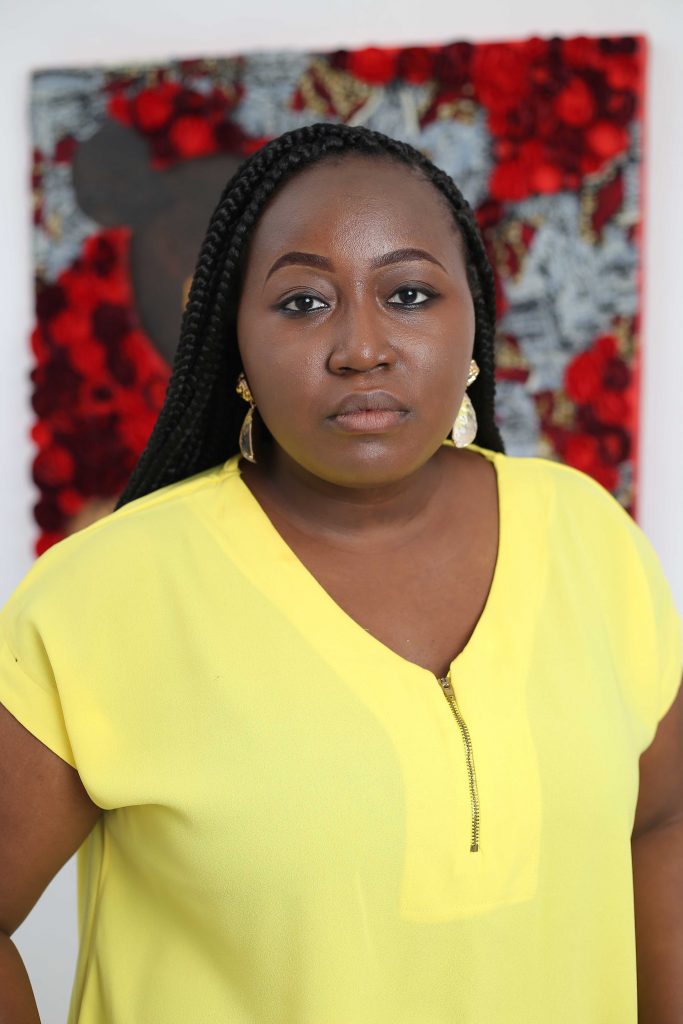
For Ayobola Kekere-Ekun, “freedom is having room to be honest with yourself, regardless of the form that might take” and this is evident in the works displayed at her latest solo exhibition, “Resilient Lines”, which showed earlier this year, at Rele Gallery. For the past 6 years, she has experimented with paper, using them in unconventional ways to explore history, and address cultural issues of gender, power dynamics, sexual violence, and the human condition, making her one of the growing notable voices in Nigeria’s art scene. From being featured in several group shows to winning The Dean Collection 20 St(art)ups Grant in 2018, Kekere-Ekun continues to evolve with tenacity and consistency that is unmatched.
Born in 1993, Ayobola Kekere-Ekun transforms paper – through a technique called quilling – into whole formations. Each strip of paper is individually shaped, placed and secured to capture pockets of light and shadow, creating personalities and shadows. She holds a BA (Hons) in Visual Arts, MA (Hons) in Graphic Design from University of Lagos and is currently pursuing a Ph.D. in Art and Design at the University of Johannesburg.
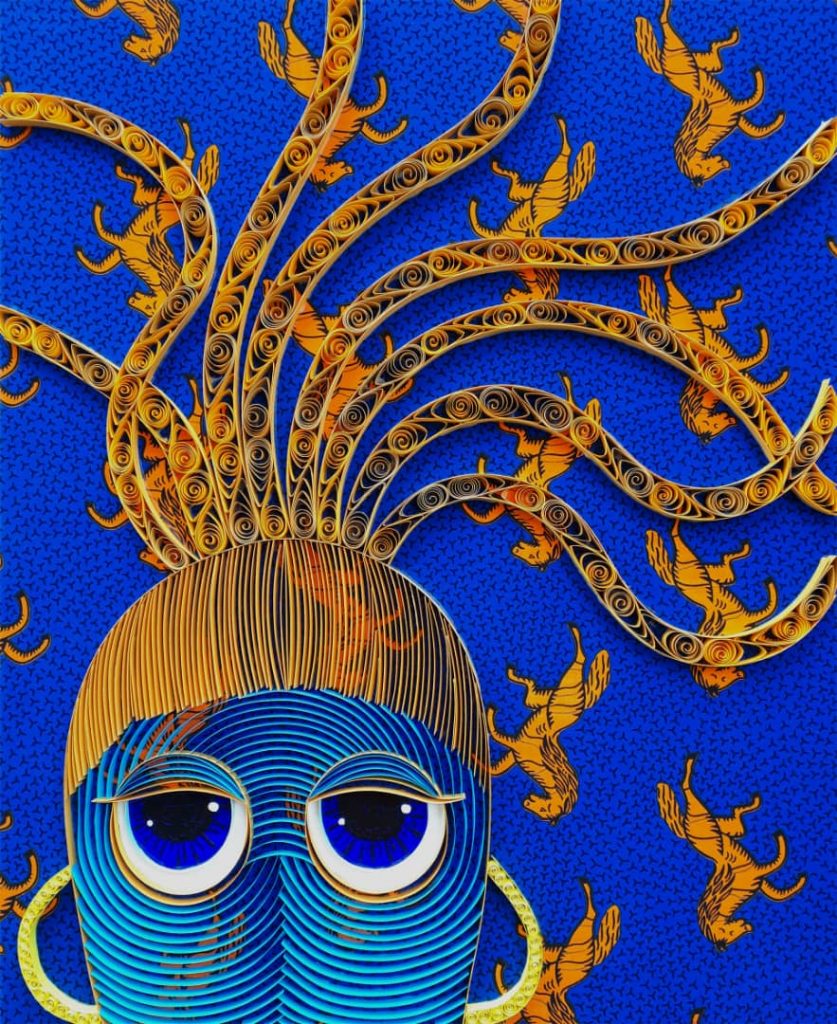
BYENYAN JESSICA BITRUS: Congratulations on the success of your first solo exhibition. Tell us about the process from conception to implementation, and balancing that with your ongoing Ph.D. in a different country.
AYOBOLA KEKERE-EKUN: It was probably the most difficult thing I’ve had to do in my practice so far because I’m a full-time student on a scholarship. It was grueling because the number of pieces I made would normally take a year but I did it in 6 months. I don’t think I would willingly take on that kind of schedule again.
The conception for the show started early. When I was writing my proposal for the grant, I was already thinking about what I’d do with the funding if I got it. I knew I wanted to do a solo exhibition but I had to mull over exactly what I wanted to say, and the value of putting a show together. By the time I got the grant, I started actually planning the series – how many pieces would be in the show, how they all fit together, and then the process of actually creating the works. I think the best way to describe it is to say it was a delicate dance between budget, time, and sanity.
BB: The grant you mentioned is The Dean Collection 20 St(art)ups Grant, by Swizz Beatz and Alicia Keys, which you were one of the 20 artists to win. How did winning that impact your work as an artist?
AK: When I turned in my application, I knew the odds of winning were low because of the thousands of people who applied. Even when I got the news, I was a bit sceptical. To be honest, I remained sceptical even after the barrage of messages and the call with Swizz. It wasn’t until we got the money that it became real. I know awards are subjective but I would be lying if I said this wasn’t more than a little validating. The 20 of us winners have become like a little family and support group. I didn’t expect to gain that in addition to the funds, so it’s been great.
The grant gave me the freedom to make choices. It put me in a position where I could make very few compromises because I was calling the shots on almost everything in relation to my work. I got a chance to do a show that was so aligned with my vision especially for my first solo, it was such a blessing. It’s easy to be dismissive of the role of money in our world but I think that’s a little short-sighted because at the very least you need resources to keep your practice going and to keep your artistic integrity without worrying about commercial viability.
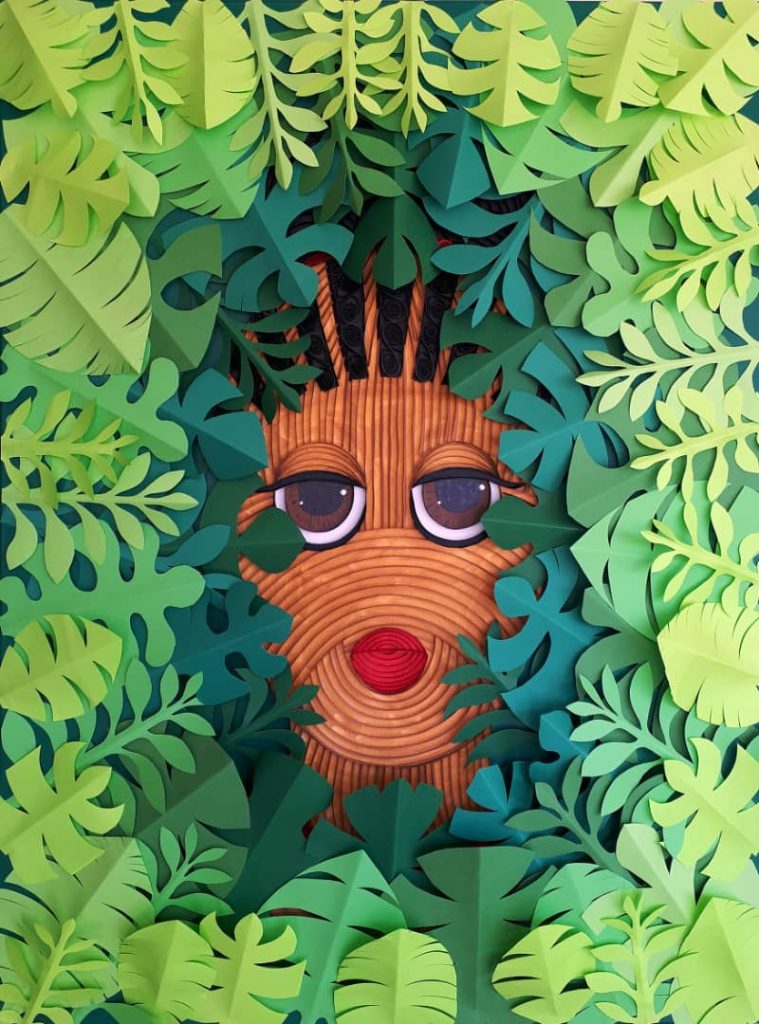
BB: Your solo exhibition, Resilient Lines, addresses issues of femininity and womanhood within the Nigerian context, using characters from Nigerian Literature and Yoruba mythology. Why did you choose this narrative, and why was it important to approach femininity through myth and mythology?
AK: The main goal of the show was to draw parallels between the experiences of women in history, mythology, literature, and reality. I’ve always enjoyed history and mythology, so it made sense for it to organically slip into my practice. I found it interesting and depressing in a way, just how clear the parallels in the women’s lives between these categories were. For example, in Lagos’ history, Àìná Eléwúrẹ́, who lived around the time of the first Ọlọ́fin, was quite wealthy but she was also unmarried and the Ọlọ́fin’s sons would often harass her, stealing from her and so on. She would report to the Ọlọ́fin, but it was disregarded because she had no man to protect her. She eventually went to the Oba of Benin to seek justice and some historians claim that was the pretext that the Oba of Benin used to annex Lagos. I found it interesting how there was a parallel between her story and single women finding it almost impossible to rent houses in Lagos. A parallel where women could have this capitalistic, patriarchal marker of success (money), but it won’t matter. It certainly didn’t matter for Àìná, and it doesn’t matter for a lot of women today who are not attached to a man. Yet, there is the narrative that money creates a level playing field. It makes me sad to see such parallels between someone who lived so long ago and 2019 womanhood. There are many other stories from which we can draw parallels, like goddesses in Yoruba mythology facing sexual violence and not getting justice.
The exhibition was an opportunity to show that women’s stories are not as cut and dry as we would like to believe. It was a chance to engage with that conversation and I think I’m particularly taken with mythology because it’s a really interesting signifier of a society’s psyche.
BB: Would it be right then to assume that you’re a feminist?
AK: Yes, I would 100% consider myself a feminist. It is common sense to want to live in a just world, where everyone has the exact same chances and expectations and can expect the same consequences. A fair world where things like gender don’t matter. My gender, which is beyond my control, should not have the power to shape my life the way it does in our society.
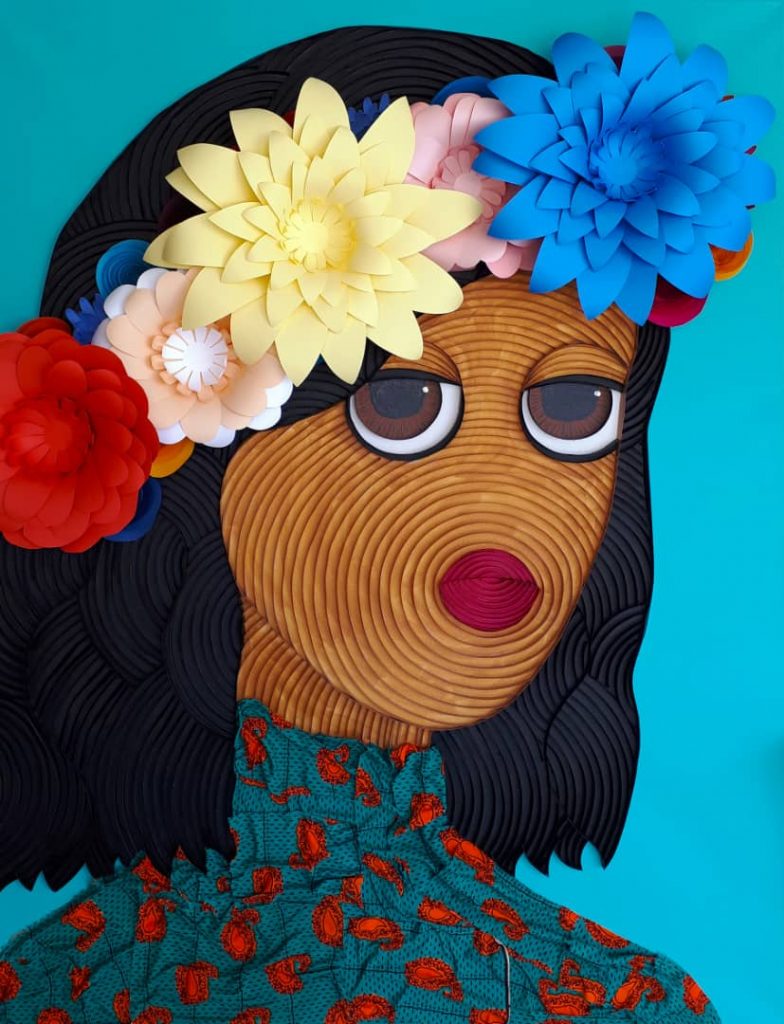
BB: Is art a path you always knew you’ll follow?
AK: I’ve always enjoyed art – looking at it, and studying it, making it. I knew I wanted to have an art-related job but for a while, I did not know exactly what it was going to be. I’m lucky to have a really supportive family. I got extra art lessons in primary school. Instead of dolls, I was the kid getting art materials. So I always had room to explore. At university, I studied graphic design, not fine art, and I think this ended up being advantageous because I did not imbibe a lot of the formal rules which I think impacts my work. I didn’t know I was going to be a studio artist until I made my first piece in my last year at university. Then the plan changed.
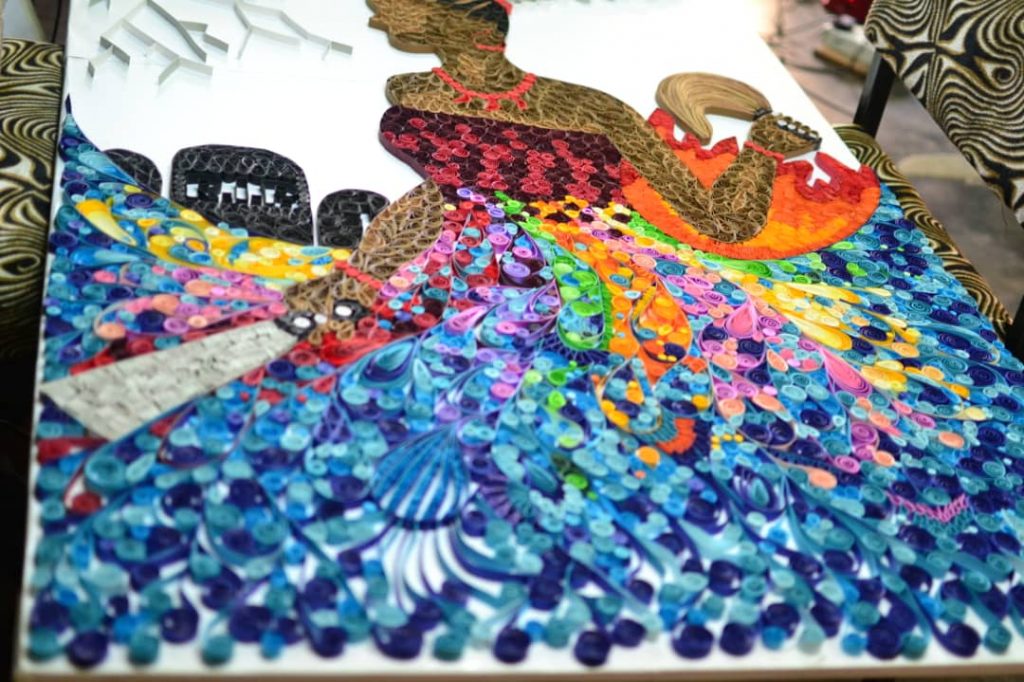
BB: Tell us about that first piece you made as an undergrad which spurred your decision to become a studio-artist.
AK: It was for my practical project for my creative arts undergraduate degree at the University of Lagos. I didn’t like painting and I knew I didn’t want to do that, so when I stumbled on the possibility of what paper could do, it made sense to take the risk. I was a bit hesitant as I didn’t really know what I was doing. Luckily, ASUU went on strike, so I had more time to work on the project which ended up taking almost 7 months to create. The piece ended up being really big, almost 4ft wide, 5ft high. I struggled through making it, making every kind of mistake possible, but it turned out to be one of the best decisions I’ve made. It was a depiction of Ọya, one of my favourite goddesses in Yoruba cosmology, who is the embodiment of justice. I find her very compelling as she’s like the guardian of women and calamitous change. If there’s like a tornado, a typhoon, a fire, or something that aggressively clears away the standing order for something new, even if it is done cruelly, she is the guardian of things like that. I guess the project was a predecessor of some of my current work.
BB: Who are artists you admire?
AK: The list tends to change often. Right now, it’s Stacey Gillian Abe, Chiharu Shiota, Nandipha Mntambo, Isabelle van Zeijl, and Wang Ziling.
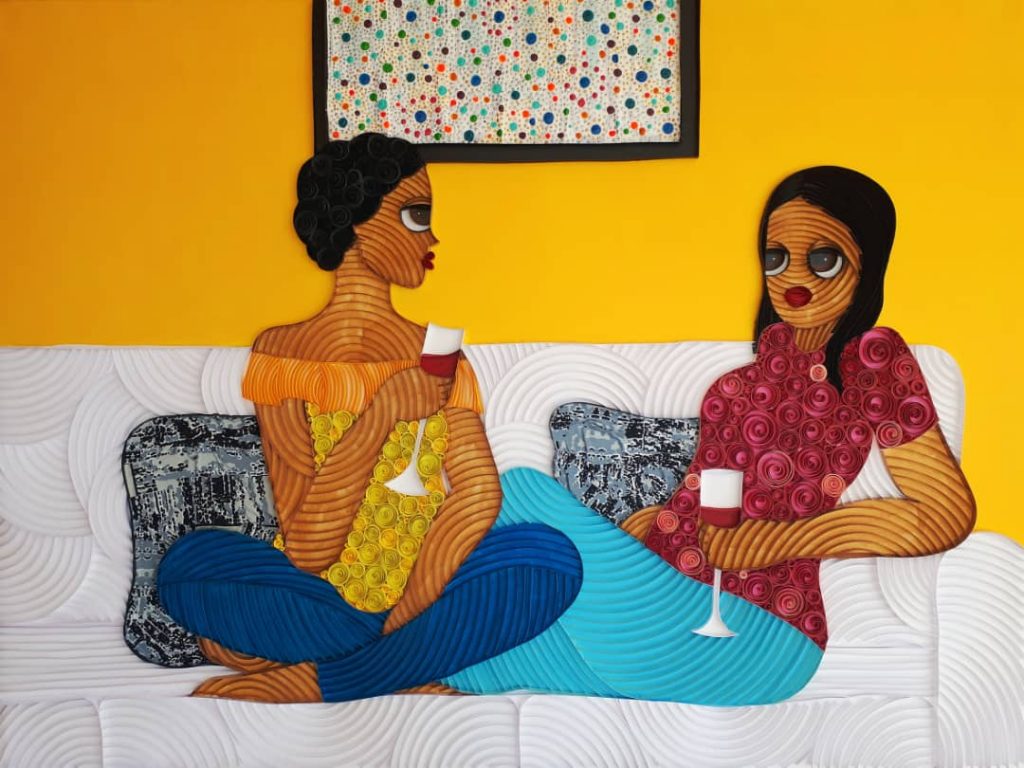
BB: Your current work seems to be introducing a new style. You’ve moved from creating just female faces to creating figurative female forms like in “First World Problems, Third World Edition”. Was this a natural progression or did it come as a way to express your new narrative?
AK: I agree that the work is starting to change, it’s a combination of factors. I’m getting more comfortable letting the work be what it wants to be, and hoping that the work resonates with someone while caring less about external factors. I’m a little less worried about how I’m perceived. A lot of the work I did for the solo exhibition are pieces that have been floating around in my head for a while. So it was really satisfying to unpack them.
“First World Problems, Third World Edition” was a challenging piece for me in the sense that it was the first time I was interrupting space with multiple figures which is something I had wanted to do for a while. I love that no one noticed that the painting in the background of that painting is actually made of sanitary pads. That series is about how easy it is for a lot of privileged Nigerian feminists, myself included, to lose sight of issues that affect underprivileged women. In this case, access to sanitary health products. And it’s not just about sanitary pads. To show you how issues like this can be so layered, it’s not just about access to the actual sanitary health products. Think about the girl from a low-income household who is already statistically less likely to complete secondary school. Does her school have toilets? Do the toilets work? Is there running water? Does the school have a school clinic to provide painkillers if she has menstrual pain? I can see how it would be easy to start missing enough days of school, for things to get problematic. It’s something we don’t really think about. And so in the piece I positioned menstrual health as a literal luxury. It was like a private joke during the exhibition for me how barely anyone noticed and I think that’s really symbolic. It’s a series I’m looking forward to unpacking further.
BB: Overtime, you’ve taken the ancient craft of quilling and owned it, creating artworks that surpass its former decorative purposes and are making strong statements in the society. How did you get introduced to the technique, and how have you evolved?
AK: I started quilling by mistake when I was in the final year of my undergraduate degree. I was walking back home and someone gave me a flyer which I began playing with. By the time I got back to my room, I had rolled it into this semi tight coil. I had a light bulb moment as I remember thinking of a way to secure it so it could hold its shape. There were these little pockets of shadows but light was also reflecting off the edge of the paper, and I just thought it was beautiful. So I went back out, bought a bunch of papers, cut them up, tried a lot of silly things, and I was on to something! After a bit of research, I found out the technique was called quilling.
Probably because I stumbled on it on my own, I didn’t feel beholden to a lot of traditional quilling rules or techniques. In my mind, I had found a way to paint without using paint because I did not like working with pigments. When you mix paint, you have unlimited possibilities and I always found the prospect of boundless choices paralysing. With paper, I found a cage to work with because I’m always going to be limited by the papers I have access to. It sounds really counterintuitive, but it’s just how my mind works.
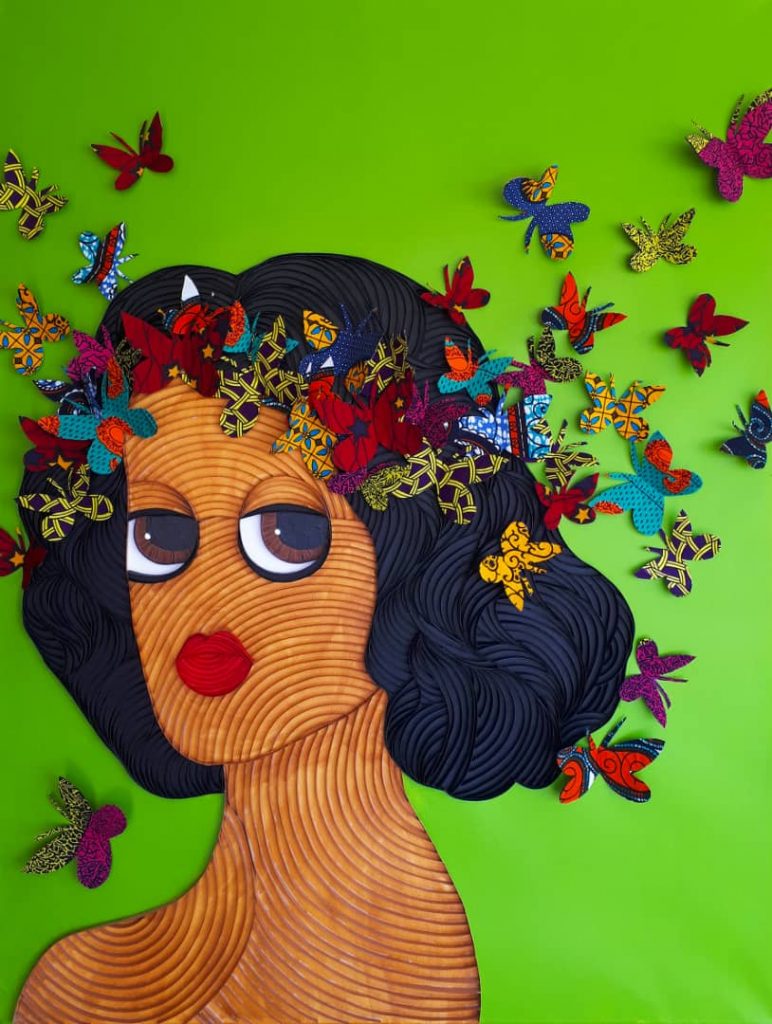
BB: Your technique also involves the use of local Ankara fabric, which was heavy in your Cultural Dysmorphia series. You have also used them, albeit lightly, in your most recent works. Is there a symbolic use of this fabric in your works?
AK: I enjoy using Ankara fabrics and I do find myself using them across bodies of work but whenever I use them, the intention is consistent. I use Ankara as a reference to the practice of Asoebi in Nigeria – a fabric that is chosen as a uniform of sorts when there’s a communal event (weddings, birthdays, funerals, and so on). I find it interesting that this idea of aso-ebi which used to be for just the family has evolved. It is symbolic how this practice has mutated from something positive. There are cases of people inflating the cost of the fabric in order to raise enough money to fund the party, or people treated badly at parties because they didn’t buy the fabric, or friendships ending over aso-ebi disputes. I think it is symbolic of our society and how we manage to corrupt things that should otherwise be positive.
I also use aso-ebi like a reference to collective thoughts. Some people feel compelled to participate, to buy the aso-ebi even when they can’t afford them. That compulsion to conform is almost always lurking. So I use it as a reference to that compulsion towards collective thoughts and interests even when that collective interest is actually very toxic.
BB: There’s been a rising number of young artists in Nigeria picked up by auction houses and featured in auctions. As a young artist yourself, is that a path you’d like to follow in the near future?
AK: When I was younger in my practice, I did do a few private auctions, mostly because you say yes to everything at the beginning of your career. Every opportunity feels important. But at this point in my practice, I wouldn’t participate in auctions because I don’t think my work is ready. Also because there would be a loss of control. It’s important to understand the difference between the primary and secondary markets, and the factors that come into play when you engage with either. My practice is not mature enough for me to be willing to take the risk of engaging the secondary market. Because of my long-term career goals, I’m very conscious of the ebb and flow of my practice, my numbers, and my prices. You lose control of that with an auction as there is no way to personally regulate what happens.
BB: You’re neck deep into your Ph.D. programme. What programme are you pursuing, and how does it connect to your artistic practice?
AK: My Ph.D. is in art and design, and my research is graphics oriented. I have my practice as an artist but in my academic life, I’m a graphic designer because my Undergraduate Degree, Master’s Degree, and now my Ph.D. are in graphic design. It was important to me to maintain a separation between the two and they have nothing to do with each other, at least not directly. My research is exploring place branding in Lagos and I found it interesting how in the past decade, the Lagos state government has been more deliberate in how they present themselves and how they curate their visual communication. My research is exploring how certain cultural and architectural monuments have been co-opted as visual signifiers of the city despite embodying problematic histories.
BB: Do you ever see yourself as a full-time artist?
AK: In my head I do, and I often find myself making decisions like a full-time artist, but in reality, I don’t think I technically am. There’s always something else that has demand on my time, first, it was lecturing, now it is school. I can’t afford to truly be a full-time artist just yet. But that is the goal, and I’m working towards it.
BB: What’s next for Ayobola Kekere-Ekun the artist?
AK: The plan is to keep working, and exploring different markets. Right now, I’m in South Africa so I’ve started to engage with the market and the ecosystem here. I recently signed with a gallery here called Guns and Rain. I love my gallerist, Julie Taylor. She’s a fabulous human being and we work really well together. I’ve had a group show here, I have another in July. I’ll be showing work at the Turbine Art Fair in July as well. There’s a whole bunch of things in the pipeline, we keep at it! So going forward, just consistency and the courage to keep trying are the things that scare me.
All images are courtesy of the artist.





Best wishes Ayobola, your visions are big. Thumbs up also to Byenyan.